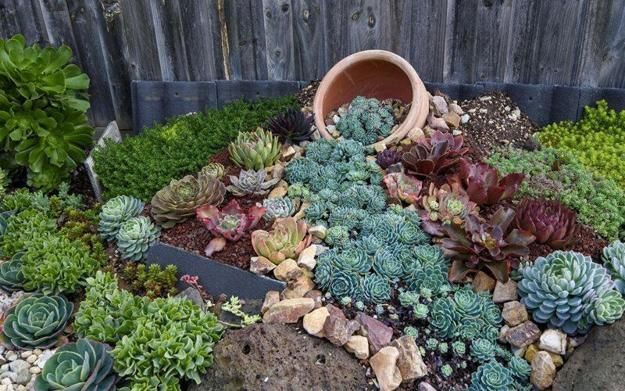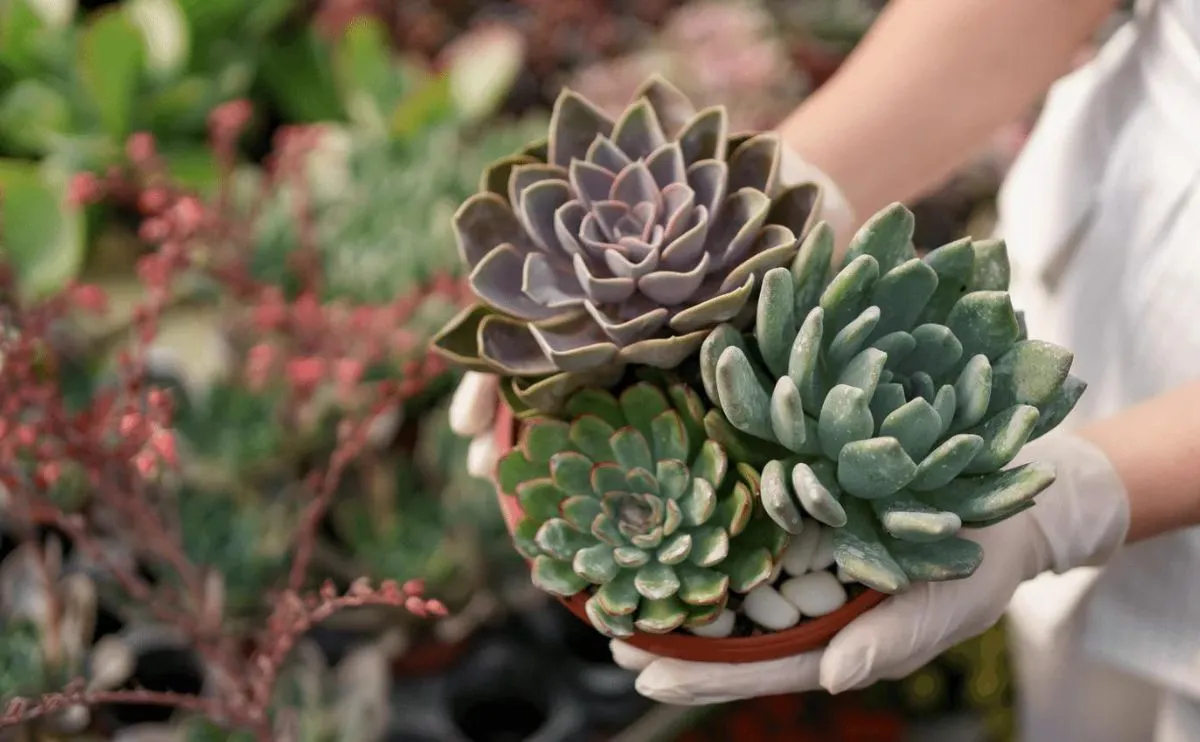Succulent gardens have grown increasingly popular over time thanks to their easy upkeep and stunning visual appeal. These unique and diverse plants thrive in all kinds of climates while needing minimal care or watering needs – ideal for any outdoor space! From large backyards and balconies alike. In this article we’ll share inspiring succulent garden…
Succulent garden design allows you to show the variety of succulent shapes, sizes and colors found within these amazing plants. By following proper techniques and design principles you can design an aesthetically pleasing garden which also proves sustainable and easy to care for over time.
Find The Ideal Spot
Step one of designing a succulent garden involves selecting an appropriate location. Most succulents benefit from being exposed to ample sunlight – at least six or more hours daily is ideal – in their environment, as this ensures sufficient root coverage while well-draining soil helps prevent root rot from happening in waterlogged locations. When selecting your spot also consider elements like wind exposure and temperature variations when choosing where best to place it.

Select The Ideal Succulent Varieties
One of the many exciting aspects of succulent garden design is selecting and placing different species to form visually striking arrangements. From popular Echeveria and Sedum to more unique Aloe and Agave species, mixing and matching species create visually captivating arrangements with stunning results. Be mindful to consider their growth habits, colors and textures when planning out your design to achieve balance and harmony for an overall harmonious garden look.
Establish A Succulent Garden Bed
A succulent garden bed allows you to easily craft an eye-catching display. Start by prepping the soil using an easily draining mix consisting of sandy and organic matter soil mixture, before organizing succulents by size, color, growth habits and maintenance needs – grouping plants together can make maintenance simpler! Consider including decorative rocks or pebbles to increase aesthetic value further.
Implement Vertical Gardens
Vertical gardens provide a creative solution to maximize limited outdoor space while adding elegance. Succulents make great vertical plants due to their shallow root systems; you can utilize various structures, like trellises or wall-mounted containers, even old pallets to create stunning succulent displays in vertical gardens. Just ensure proper irrigation, selecting drought tolerant varieties.
Plant Succulents In Containers
Succulents make excellent choices for balconies, patios, or small gardens when planted in containers with drainage holes to avoid waterlogging issues. Experiment with different container shapes, sizes and materials to add visual interest and create stunning arrangements by grouping various succulent species together while considering their growth habits and color palettes when designing an arrangement in one container.
Add Accent Features
To increase the overall visual appeal of your succulent garden, consider including accent features. From sculptures and driftwood pieces, to colorful pebbles or sculptures; accent features can give your design that extra special something! Additionally, low maintenance plants such as ornamental grasses or flowering perennials may help diversify and round off this living landscape more fully.
Design And Implement a Rock Garden
Rock gardens make an excellent backdrop for succulent displays, adding naturalistic charm. Simply arrange rocks and boulders of various heights and visual interest into an eye-catching rock garden layout and nestle succulents among these rocks accordingly based on size, color contrast, or other considerations – creating an engaging display reminiscent of their native habitat and creating visually striking succulent gardens!
Construct A Succulent Wall
Succulent walls (commonly referred to as living or green walls) are vertical structures covered with plants for aesthetic effect and living art pieces. To build one yourself, utilize a modular gardening system designed specifically for vertical gardening before selecting and placing succulent species according to their growth habits and colors patterns on a modular rack for vertical gardening. Ongoing maintenance should ensure longevity for this form of vertical gardening art!
Combine Succulents With Other Plants
For an eye-catching and visually diverse garden space, combine succulents with other types of plants. Integrating succulents into flowering plants or ornamental grasses will add color, texture and seasonal interest into the mix – so be mindful when selecting which succulents go together when selecting which other species. Take note of each plants individual growth requirements to create an inviting garden space where everyone thrives!
Maintenance and Care Tips
Although succulent gardens tend to require only minimal upkeep, some care must still be given for a thriving succulent garden: Here are a few maintenance and care tips to maintain its success:
Water sparingly: Succulents thrive in dry conditions and overwatering them can result in root rot. When watering succulents, only do so when the soil has completely dried out to ensure good drainage and ensure sufficient drainage of excess liquid from their pots.
Provide adequate sunlight: Succulents require at least six hours of direct sunlight daily in order to flourish properly, so ensure that your garden receives sufficient light exposure in order to maximize healthy growth.
Protect from extreme temperatures: Some succulents are delicate creatures and require special consideration in terms of cold or heat conditions, so when necessary move indoors for protection and offer shade or shelter.
Regularly remove dead leaves and debris to protect against pests, diseases and maintain an attractive space. This practice helps ensure pests, diseases and clutter don’t take hold and threaten its wellbeing.

Protect Succulents In Different Climates
Succulents thrive in various climates, yet some species require extra care during extreme conditions. When growing succulents in cold environments such as temperatures below zero F or in arid regions with lots of sunburn exposure. When placing succulents outdoors during these times of year it’s wise to provide your succulent with enough shade in the form of shade cloth, frost cloth or indoor storage during winter if possible – ensure all their needs are being met for your region and succulent species in this climate zone before purchasing any specific requirements specific species before placing plants into soil for long term success! Research all requirements so your succulent species is properly cared for!
Common Issues
Succulents are resilient plants, yet occasionally you might come across some problems that need fixing. Here are a few troubleshooting tips:
Overwatering
Are your succulents looking wilted or yellowing due to too much water being provided? Make adjustments in order to ensure adequate drainage in their soil environment.
Pest Infestations
Common plant pests include aphids, mealybugs and spider mites; treat infested plants using insecticidal soap or neem oil to eliminate these nuisances.
Root Rot
Overwatering or improper drainage may result in root rot. If affected roots appear mushy or blackened, remove and repot them into an environment with adequate drainage for best results.
Harvest And Propagate Succulents
Succulents offer great opportunities for propagation, making the plants easily expand your collection or share plants with others. Common methods of propagation are leaf cuttings, stem cuttings or offsets – to be successful follow proper techniques while providing conditions like well-draining soil and indirect sunlight for success!
Conclusion
Planting a succulent garden offers unlimited potential to transform an outdoor space into something truly remarkable while remaining low maintenance. By selecting an ideal location and choosing suitable succulent varieties with creative design ideas in mind, creating your garden will become a beautiful oasis! Just ensure adequate care is taken with all succulent plants for its health and long life span.
FAQs (Frequently Asked Questions)
Q1. Can I Grow Succulents Indoors?
Absolutely, succulents can thrive indoors provided they receive enough sunlight and care. Choose species which thrive well indoors as well as well-draining soil to provide proper conditions.
Question 2: When should I water my succulent garden?
Succulents have low water requirements; best to water only when their soil dries completely out (depending on climate and humidity levels, this could take anywhere between one week to every few weeks).
Q3: Are succulents pet-safe?
While most succulent species are nontoxic to pets, it’s wise to conduct research before adding new succulent species into the home or garden – some species could still cause mild stomach upset ingestion – which should always be done prior to any introductions of new succulent species into either.
Q4: Can succulents thrive in humid environments?
In general, succulents prefer dry environments; however they can adapt to humid environments with proper ventilation and well-draining soil; avoid overwatering to avoid root rot in humid climates.
Q5: How can I avoid overwatering my succulents?
To prevent overwatering, make sure the soil dries out between watering sessions. Select an easy draining potting mix for best results, watering each plant thoroughly while allowing any extra liquid to drain away naturally and avoid leaving your plants with standing water in their roots.



